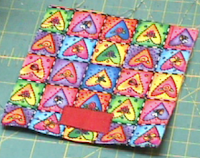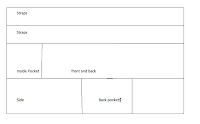Pockets...
There are three types of pockets in this bag by byAnnie! and one that I decided to do on my own!
 |
| Zippered Pocket |
 |
Slot pockets |
 |
| Vinyl Pocket |
 |
| Exterior pouch pocket |
Zippered Pocket.
This pocket was not in byAnnie's pattern. Since I am now working on my second bag, It was time for me to add my own touches. I wanted to put a zippered pocket somewhere, and this seemed to be the perfect spot... I found this video on how to put a zipper in a pocket. It was very different than the way I usually would have done it so I gave it a try. Go and watch it... I will wait! |
| Karen Comstock from QuiltTricks explains how to put a zipper in a pocket. |
One thing I always do when I want the stop of the zipper just inside my seam line as shown in the video, is to mark my 1/4 inch line and make sure I place the stop about an 1/8th of an inch in from the line. That way I always know I won't be hitting it with my needle.
 |
| Placing the zipper stop inside the 1/4 inch seam allowance. |
I don't have a walking foot for my Bernina 830, it has Dual Feed, which is great for the things I use it for. (I do all my quilting on a Long Arm so I have no need for a walking foot!) I just used my Open Toe Foot on my 830 and it worked perfectly for me.
I liked this technique and will try it again on some other projects. I did rip a few times because I sewed too close to the zipper, but I will know better next time.
I made bar tacks at both ends of the zipper. I like to get the open end at the zipper stop closed to make it easier for me to sew the pieces together later.
 |
| Zipped pocket. |
I attached my zipped pocket to a Slot Pocket piece with stabilizer on it, but I wouldn't have had to do that I don't think if I had remembered to stabilize the pocket pieces.
Slot Pockets
Slot Pockets are very handy for credit cards, customer appreciation cards, small pictures and they are simple to do. |
| I have a very inexpensive iron that I purchased just for sticky stuff. I mark it so no one uses it on their fabrics with out a pressing sheet. |
 |
| Interfaced piece. Interfacing was cut 1/4" smaller than pattern piece. |
Each pattern piece is cut, pressed, folded in half and top stitched. EASY!
Vinyl Pocket.
This little pocket will be a great little pocket for the girls to put pictures of their latest dream boyfriend. (Not sure if it's still Justin Beeber or not! LOL). Its also a great pocket for your drivers license or any other ID you like to carry with you.
 |
| Video tutorial from byAnnie! |
I am not going to pretend I know anything about sewing on Vinyl, never mind binding it so I am going to send you over to Annie... she has a great video tutorial at her site, just for those of us who have no clue how to get this sticky stuff through our machine!
I will wait while you go watch!...
And that is all there is to that...
 |
| Vinyl pocket attached! |
Exterior Pouch Pocket
If you have been following along, earlier I mentioned that while reading the pattern I had some concerns about 1 part of it. This was it... Turns out it was very simple!
The exterior pocket starts out like the slot pockets. You interface the pattern piece, fold it in half, then top stitch.
Now you need to stitch again to make a tunnel for your elastic. I like to back stitch at each end of this stitching to make sure this seam doesn't come apart while you are stretching the fabric.
 |
| I love the Frixion pens for marking lines where I will be sewing. They iron right out when I am done with them. |
When I am sewing lines of stitching that I know will be used for elastic, I usually use a very narrow zigzag, sewn at my normal stitch length... 2.0 on my machine.
The next part is adding the Velcro piece. I always use a small zig zag to sew around the edge and always sew twice. Put the extra piece on top of it (you will use it later) before you move to the next step. You know your going to lose it if you don't!!
The next step is the tricky part.
First you want to cut out small corners at the bottom of the piece
 |
| Cut through both layers. |
Next you want to separate the layers and...
 |
| Separate layers. |
fold each corner, right sides together and...
 |
| Fold corners right sides together |
stitch...
 |
| All four corners stitched. |
Tuck corners into each other to form pouch, and...
Add Elastic and...
 |
| A bodkin or a safety pin works well for this step. |
the pouch pocket is done and ready to attach.
OK... that's it for today. I will be back on Monday with the next step!
Note... I just need to keep reminding you that I am not employed by any of the companies I have talked about today. Just a happy customer!
 |
| I love these little snap pouches. They are great for carrying small objects in one of your purses. But, I am afraid, they will not fit into this bag! |






























